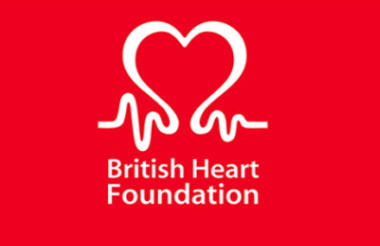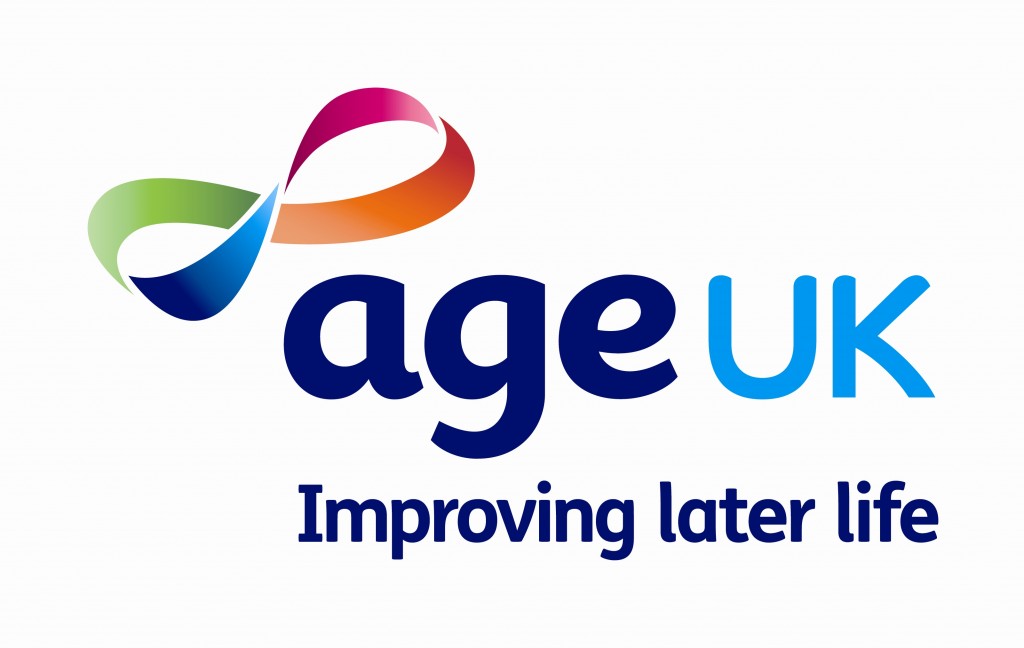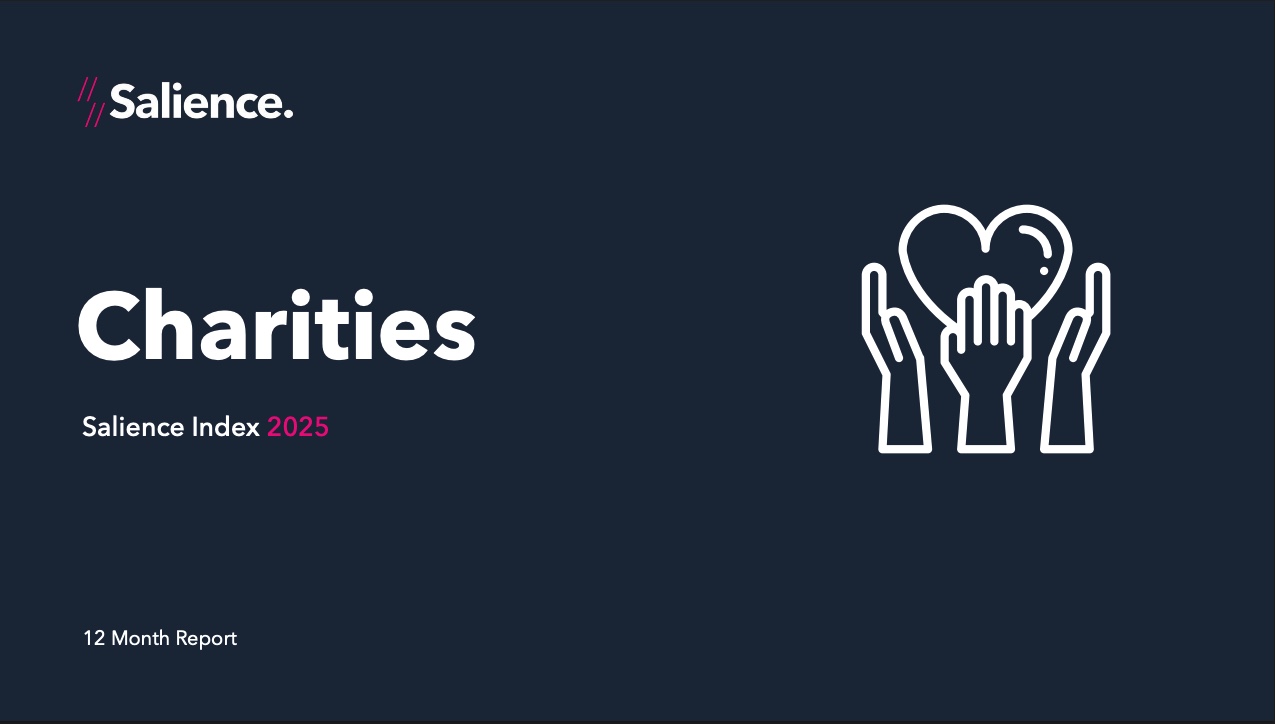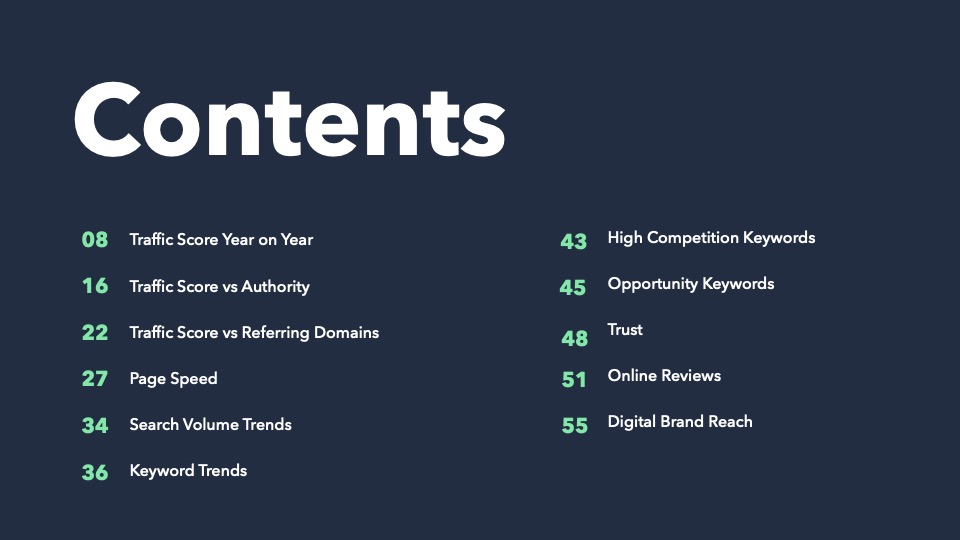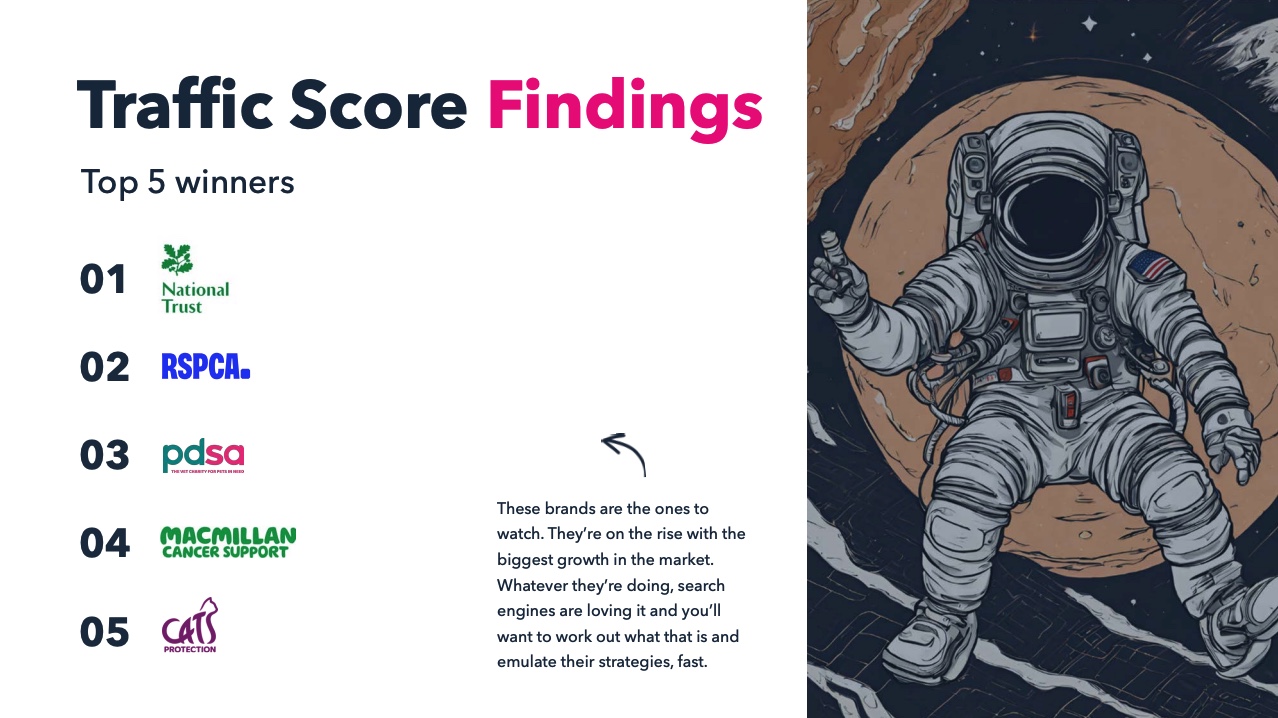Want the full picture? Get the free 69-page report for deeper insight and all 100 rankings. Download the Charity Market Report.
How the Index measures performance (and why it matters)
We use an organic Traffic Score as a relative indicator of monthly search visibility. It’s calculated from the keywords a site ranks for, the positions held, search volumes, and an estimated CTR by position. Think of it as a league-table lens on organic search: not a substitute for analytics, but a reliable way to compare growth and momentum across the sector.
This year’s macro signal is steadiness with turbulence: Industry Variance: +2%. If the market creeps up and you don’t, competitors are quietly outpacing you.
Which charities dominate organic visibility in 2025?
The top tier is packed with household names and strong content footprints. Here’s the upper table from the latest Index:
| Rank | Brand | Traffic Score (Sep ’25) | Traffic Score (Sep ’24) | YoY Change | vs Market |
|---|---|---|---|---|---|
| 1 | nationaltrust.org.uk | 2,122,186 | 1,955,625 | +9% | +7% |
| 2 | bhf.org.uk | 1,363,528 | 1,411,016 | −3% | −5% |
| 3 | cancerresearchuk.org | 1,203,807 | 1,241,752 | −3% | −5% |
| 4 | rspb.org.uk | 788,425 | 742,837 | +6% | +4% |
| 5 | diabetes.org.uk | 649,710 | 1,265,056 | −49% | −51% |
| 6 | rspca.org.uk | 622,742 | 537,959 | +16% | +14% |
| 7 | mind.org.uk | 571,266 | 562,340 | +2% | — |
| 8 | ageuk.org.uk | 555,428 | 583,799 | −5% | −7% |
| 9 | pdsa.org.uk | 480,221 | 362,701 | +32% | +30% |
| 10 | macmillan.org.uk | 470,271 | 401,772 | +17% | +15% |
What the table says: visibility leadership remains concentrated among national institutions with expansive content and strong brand signals. Notably, diabetes.org.uk sheds almost half its estimated traffic, while rspca.org.uk and pdsa.org.uk push on with double-digit gains—evidence that entrenched categories can move quickly when content depth, technical health and authority align.
Why it matters for you: dominance does not guarantee resilience. Even top-10 brands show volatility. For leaders, this points to the need to defend non-brand terms and category hubs with fresher, intent-matched content. For challengers, the gap is bridgeable: growth pockets appear where user problems are solved more clearly and quickly (think “how-to”, eligibility, localised services, and evergreen guidance that earns links).
Where the action is: the volatile middle (and the rise of Woodgreen)
Movement accelerates in positions 25–54. Here are the standouts:
| Rank | Brand | YoY Rank Change | Traffic Score (Sep ’25) | Traffic Score (Sep ’24) | YoY Change | vs Market |
|---|---|---|---|---|---|---|
| 25 | sja.org.uk | +2 | 159,662 | 116,718 | +37% | +35% |
| 28 | samaritans.org | +6 | 104,880 | 83,284 | +26% | +24% |
| 32 | girlguiding.org.uk | +11 | 97,372 | 64,549 | +51% | +49% |
| 34 | prostatecanceruk.org | +8 | 92,308 | 65,522 | +41% | +39% |
| 38 | rnli.org | +7 | 79,789 | 53,228 | +50% | +48% |
| 43 | comicrelief.com | +7 | 69,441 | 45,075 | +54% | +52% |
| 44 | bbcchildreninneed.co.uk | +8 | 65,179 | 39,897 | +63% | +61% |
| 45 | woodgreen.org.uk | +9 | 64,418 | 37,991 | +70% | +68% |
| 50 | kidneyresearchuk.org | +16 | 53,336 | 17,663 | +202% | +200% |
What the table says: the mid-table is where momentum compounds. Woodgreen and Kidney Research UK demonstrate how targeted content + technical clarity + authority can outstrip a flat market. Meanwhile, seasonal or campaign-heavy charities (e.g., Comic Relief, BBC Children in Need) capture large spikes and carry them through with evergreen pages.
Why it matters for you: mid-table brands have leverage. Gains here often come from building and interlinking topic clusters, reducing conversion friction, and reinforcing E-E-A-T via tangible services, guidelines and community proof. The takeaway is simple: you don’t need to be a household name to post outsized wins.
Spotlight: Woodgreen’s education-first growth engine
Most animal charities pull on heartstrings. Woodgreen is doing that and something else: turning high-intent advice seekers into supporters.
What the numbers tell us
- Rank: 45th (up nine places from 54th)
- YoY visibility growth: +70% vs +2% market variance
- Estimated Traffic Score (Sep ’25): 64,418 (37,991 a year prior)
- Brand search demand: c. 110,000 UK monthly searches for “woodgreen” (trend currently down YoY, but the base is substantial)
Why this approach works
- Education first. Woodgreen’s structure puts “Help and support” front and centre, leading to a deep Pet advice hub covering behaviour, nutrition, and welfare across species. Articles address specific owner problems in plain English, then cross-link to training, rehoming and—critically—donation pages. This builds topical authority and routes intent cleanly.
- Frictionless giving. Donation pathways are short, with preset amounts, a simple monthly/one-off toggle and clear statements of impact. Micro-asks appear inside advice content the moment value is delivered (“help keep our advice free”). The nudge lands when trust is highest.
- Empathetic storytelling. Rather than generic pleas, Woodgreen leads with specific cases and transparent outcomes. This humanises the mission without guilt tactics and ties the advice engine back to the animals it serves.
What you can take from it: meet users at the problem. Build service-grade advice that genuinely resolves it. Interlink it to services and a low-friction ask. That sequence converts gratitude into recurring support.
Curious how a charity stack like this comes together end-to-end? Learn more about our Charity SEO approach and how we blend content, CRO and Google Ad Grants. See the Charity service page.
Are brand and search trends aligned—or drifting apart?
Two currents run through this year’s data: a handful of emerging informational themes, and a long list of receding “donation logistics” queries. That tallies with what we see on the ground: donors want clarity, cause fit and ease over warehouse-style pick-ups.
Emerging queries (opportunities for content hubs)
- charitable donations (+16%)
- charity events (+20%)
- charity fundraising (+20%)
- ramadan charity (+129%)
- christmas charities (+167%)
- online fundraising (+110%)
- fundraising websites (+39%)
- charities to donate to (+32%)
- charity donation pick up (+97%)
What this says: intent is clustering around when and how to give, and around cultural or seasonal frames. Brands that pre-build guides and landing pages for peak moments (“Ramadan giving”, “Christmas appeals”, “Run for charity”) stand to capture attention and grow non-brand share.
Receding queries (signals of changing behaviour)
- donate furniture to charity (−23%) and charity shops accepting donations (−53%)
- charity organisations near me (−42%) and charities that take furniture (−42%)
- bra donation (−18%), prom dress donation (−34%)
- donate toiletries (−35%), animal shelter donations near me (−52%)
What this says: logistics-heavy donation searches are ebbing. That aligns with the channel shift towards digital donations, events and peer-to-peer fundraising. If your site leans on “what we accept in store” content, consider redistributing effort into evergreen giving guides, event onboarding and digital wallets.
Brand search picture
Emerging brands: Dog Trust, Oxfam, Samaritans, Barnardo’s, Mind, Marie Curie, Salvation Army, Blue Cross, DofE, Scouts, WWF, Scope, Save the Children, Comic Relief all show positive interest trends.
Receding brands: Cats (generic brand term), National Trust, Woodgreen, PDSA, Diabetes, Battersea, RSPB, Macmillan, Shelter, NSPCC and others dip year-on-year.
What this says: brand interest now swings on narrative freshness and omnichannel presence more than category heft. A falling brand-search trend doesn’t doom growth—Woodgreen proves you can expand non-brand visibility while brand demand softens—yet it does put a premium on PR, partnerships and social formats that spark recall.
High-velocity movers and the market story behind them
- kidneyresearchuk.org: +202% YoY and up 16 places. Likely the product of concentrated content expansion around high-intent queries, a tidy internal link graph, and a reinforcement loop from PR to guidance pages.
- girlguiding.org.uk: +51%, up 11 places. A classic case of consolidating authority by aligning informational resources with clear action pages (join, volunteer, find a unit).
- rnli.org: +50%, up 7. Strong seasonal and campaign narratives that convert into evergreen safety and education content.
Algorithms still rewards depth + clarity + authority, especially in problem-solving content. Sites that tidy technical debt and re-house information in intuitive hubs are the ones punching above the +2% market drift.
Which charity website patterns are winning in 2025?
From the service side, three UX traits show up again and again on the winners’ sites:
- Short, decisive donation flows. Presets, monthly/one-off toggles, and minimal fields. Every extra step costs conversions.
- Advice as a service. Treat informational content like a product: taxonomy, searchability, related content, and a visible upgrade path (donate, volunteer, book, refer).
- Proof everywhere. Reviews, case stories, volunteer quotes, and transparent “where your money goes” pages. This is the most efficient way to build trust and satisfy E-E-A-T.
Want to see how these elements come together in real campaigns? Explore our client work (including projects comparable to Woodgreen). Browse our case studies.
Tables & takeaways
A. Top-10 visibility leaders (quick recap)
National Trust still leads the pack; RSPCA and PDSA post strong double-digit gains.
A big brand can still decline: Diabetes UK illustrates the risk of resting on authority.
Strategic hint: leaders may need to protect generics with topic-cluster refreshes and FAQ-rich hub pages aligned to volunteer/donate flows.
B. Mid-table movers to watch
Woodgreen: education-first content and low-friction asks deliver +70% YoY.
Comic Relief, BBC Children in Need: seasonal spikes can become sustained growth with evergreen landing structures.
Kidney Research UK: three-digit growth shows what’s possible with focus.
Strategic hint: challengers should double down on evergreen advice hubs, internal linking and simple, transparent donation UX.
C. Keyword currents (emerging vs receding)
Rising intent clusters around events, seasonal giving, religious observance and digital donation infrastructure.
Falling interest in physical donation logistics suggests a content re-balance away from store lists and towards online/supporter journeys.
Strategic hint: prepare content ahead of peaks (e.g., Ramadan, Christmas) and build modular landing pages that roll over annually.
Woodgreen, step by step: how advice turns into action
- Search for pet advice — user Googles a pain-point (e.g., “stop puppy barking at night”).
- Finds a comprehensive guide — structured to offer quick answers, deeper dives and related topics.
- Meets the mission — the guide connects to services and rehoming, explaining impact.
- Converts — a contextually-placed, simple donation button turns gratitude into a gift.
This isn’t theoretical; it’s how the site is structured. The magic is the value exchange: help first, ask second. Done consistently, that loop grows non-brand visibility and stabilises income across seasons.
Directional insights for 2025 charity marketers
- Build (or overhaul) an advice hub. Prioritise problems your audience actually types into Google. Map them into clusters and interlink ruthlessly. Treat each hub as a service with clear upgrade paths.
- Strip friction from donations. Preset values, monthly toggles, ultra-short forms. Place donation prompts at the moment of value—inside advice content, event onboarding and results pages.
- Seasonal playbooks beat one-off campaigns. Pre-build landing frameworks for Ramadan, Christmas and event season. Roll them forward each year, updating examples and stories.
- Balance brand and generic. Keep brand recall warm through PR and social formats that travel, but dedicate the lion’s share of content expansion to non-brand queries your supporters care about.
- Let proof do the persuasion. Show outcomes, share reviews, and publish “where your money goes” pages. It builds trust for both users and algorithms.
Which charity keywords are hardest to win in 2025?
High-competition terms tend to sit at the intersection of broad intent and high trust requirements. A few of the toughest battlegrounds in the Index include:
| Keyword | UK monthly searches | Competitiveness |
|---|---|---|
| charitable donations | 1,600 | 52 |
| find a charity | 1,300 | 76 |
| palestine charity | 1,100 | 72 |
| charity fundraising | 700 | 83 |
| environmental charities | 600 | 85 |
| christian charity | 600 | 87 |
| charity website | 450 | 96 |
| fundraising websites | 400 | 89 |
How to read this: these aren’t just “big volume” phrases; they’re qualification tests. Users want clarity on impact, legitimacy and next steps. Winning pages tend to demonstrate purpose quickly (what you do, where money goes), resolve ambiguity (who you are for) and offer one crisp action.
Where are the low-competition opportunities?
Plenty of useful, lower-barrier terms remain under-served—ideal for challengers building momentum and for leaders seeking incremental gains:
| Keyword | UK monthly searches | Competitiveness |
|---|---|---|
| small charities | 100 | 28 |
| charitable causes | 100 | 29 |
| charities that collect items | 150 | 24 |
| donate old computers to charity near me | 150 | 31 |
| charities that take furniture | 250 | 15 |
| charity box near me | 350 | 40 |
| charity donation pick up | 150 | 44 |
| christmas charities | 200 | 25 |
| life charity | 200 | 38 |
How to use this: treat these as hub feeders. Create helpful, localised pages that answer the query directly, then bridge into the core journey (donate, volunteer, refer, learn). They won’t all be conversion workhorses, but they build topical breadth and internal link equity that lifts entire clusters.
Brand reach and social momentum: what’s shifting?
We see a split between brands adding fresh narratives and those relying on past reputation. Dog Trust, Oxfam, Samaritans, Barnardo’s, Mind, Marie Curie, Salvation Army, Blue Cross, DofE, Scouts, WWF, Scope, Save the Children and Comic Relief are gaining interest. Meanwhile, National Trust, Woodgreen, PDSA, RSPB, Macmillan, Shelter, NSPCC and others soften year-on-year.
So what? This tilts strategy towards story velocity: campaigns that travel across channels (PR, social short-form, partnerships) and deposit attention back into evergreen guides and service pages. Even if your brand trend is flat, non-brand growth can carry total visibility when your informational assets are strong.
National vs specialist charities: different paths to the same outcome
Nationals (e.g., National Trust, BHF, Cancer Research UK): defend breadth. Consolidate overlapping content, harden internal linking from editorial to action pages, and refresh seasonal frameworks early.
Specialists (e.g., Woodgreen, Kidney Research UK, Girlguiding): win depth. Own problem-space clusters completely, publish service-grade advice, and surface evidence (stories, outcomes) at critical moments in the journey.
Both groups benefit from technical hygiene (crawlability, CWV, schema) and from showing proof (reviews, outcomes) inline rather than on orphaned pages.
Technical hygiene & CRO: a fast checklist for charity teams
- Fix crawl debt: canonical noise, thin tag pages, parameter bloat.
- Tighten templates: crystal-clear H1s, meaningful intros, related-content blocks and breadcrumbs.
- Speed first: images sized and lazy-loaded; JS trimmed; caching tuned.
- Schema: Organisation, FAQ, HowTo, Event and Donate where appropriate.
- Donation UX: preset values, monthly toggle, minimal fields, transparent outcomes.
- Advice UX: problem → solution → options; clear upgrade paths to donate/volunteer.
Final word
The 2025 charity search landscape rewards brands that respect users’ time and intent. Woodgreen shows what happens when a charity behaves like a service: answer the question, then make support effortless. Whether you’re top-10 or mid-table, the signal is the same—clarity, usefulness and trust compound.
If you’re ready to apply the playbook without burning cycles, you can learn more about our Charity SEO service and how we’d approach your roadmap.


